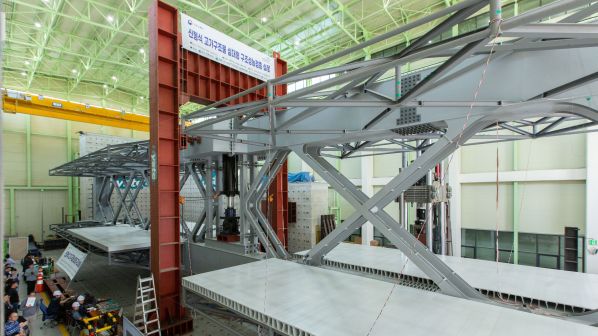ATTENDEES at a special event held at Myongji University’s Hybrid Structural Testing Centre in May 2023 were among the first to witness the capabilities of a new structure design that could revolutionise elevated light rail construction.
The Korea Railway Research Institute (KRRI) began work on the Sky Guideway in 2018 as a research project in collaboration with the Korean Ministry of Land, Infrastructure and Transport (Molit). Dutch architect ZJA was subsequently commissioned by KRRI and its construction partner GS E&C to design an economically viable, elegant, sustainable and innovative elevated light rail superstructure, the prototype of which is now available for public viewing.
The design thinking behind the new structure is readily apparent. The upper section’s aesthetically pleasing canopy, which incorporates a lattice style design of organic lines and curves, is intended to mitigate noise from trains, while ensuring safe operations during extreme weather conditions. This offers a potentially fresh and more desirable look for elevated infrastructure – it is described by the architects as soaring like a waving line, making the structure appear as though it is floating above the city. However, the real innovation is found in the extended spacing of the structure’s supporting piers at 200m intervals, creating an increased feeling of space beneath the structure.
The new design is based on the principles of the I-beam profile. Using a central beam between the tracks with flanges cantilevered outwards makes it possible to offer the extended distances between the piers, even at heights of 15m. Passenger views from one side of the train are also not impeded by the walls of the structure.
The roof has an important structural function in spreading forces. In addition, the combined weight of the upper and lower sections of the Sky Guideway are 20% lighter than existing box girder bridge designs, and 80% lighter than concrete floor slab designs. This reduction in weight allows for an increased span without the need for cables.
“During the remaining research period, we plan to conclude performance verification of the Sky Guideway.”
Mr Shin Jeong-yeol, KRRI research director
The width of the lower columns has also been reduced from 2.5m to 1.5m, limiting the footprint of the elevated structure and providing the capability for installation in the median of multi-lane roads with minimal impact on the space available for traffic.
The capabilities of the Sky Guideway were demonstrated during a live test held during the event in collaboration with Busan Transportation, GS Construction, Dong-A Engineering and other companies. The central span, the most vulnerable part of the structure, was subjected to a test load of to 430 tonnes, with the test successfully verifying safety levels of more than 120%.
KRRI says that the structure’s upper and lower sections are designed to be mass produced in a factory and then assembled on site in modules using specialist equipment. Digital twin technology and Lidar-equipped drones are used alongside other tools to capture real-time information on construction details, which is then checked against the building information model (BIM) for accurate construction. It is hoped that this fast but thorough construction method will ultimately reduce construction times and associated disruption to traffic and pedestrians in busy city centres.
Cities throughout Korea including Seoul, Busan, Daegu and Incheon, have launched light rail projects since 2011. Elevated projects have adopted traditional bridge structures featuring piers that are spaced at 3-40m intervals and incorporate a heavy superstructure placed on top.
Due to issues such as noise, increased congestion and neighbourhoods being divided by elevated rail structures, many Korean citizens have called for new light rail lines to be built underground. However, the increased costs that projects of this type would entail are prohibitive.
Revitalise light rail
KRRI says it hopes the introduction of the Sky Guideway will revitalise light rail as a viable urban transport option in Korea. Success at home is also expected to pave the way for expansion into Southeast Asia and other international light rail markets.
Indeed, the project was recognised as the Gold Winner in the Future Projects - Transport category at the World Architectural News Awards in November last year, emphasising its potential attractiveness to cities looking to build new elevated infrastructure.
“As each local government pursues light rail projects to alleviate traffic congestion caused by urban overcrowding, the development of technologies that can address the issues of urban fragmentation, visual impact, traffic congestion, noise and accidents during severe weather conditions is crucial,” says KRRI research director, Mr Shin Jeong-yeol.
“During the remaining research period, we plan to conclude performance verification of the Sky Guideway and make every effort to implement it across future national routes as soon as possible.”

